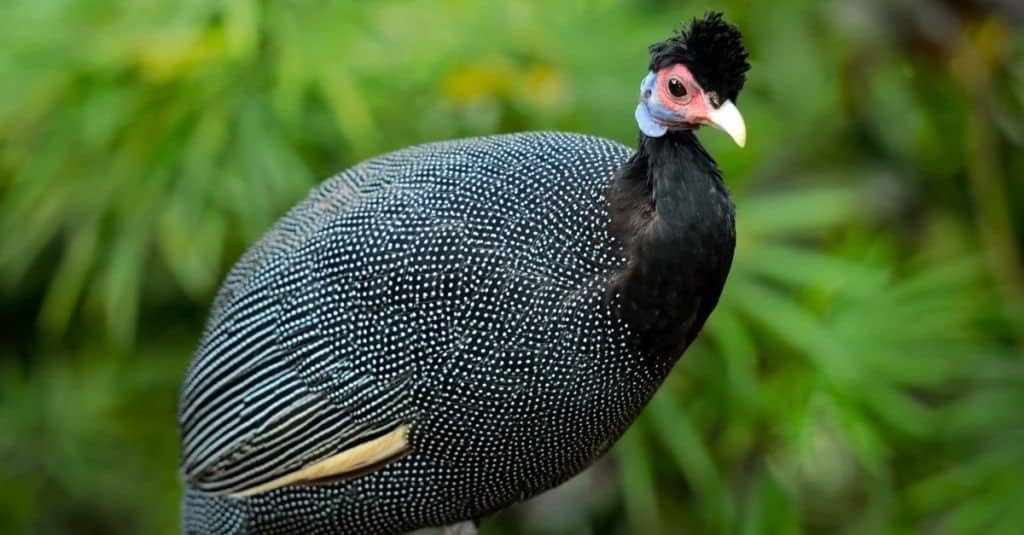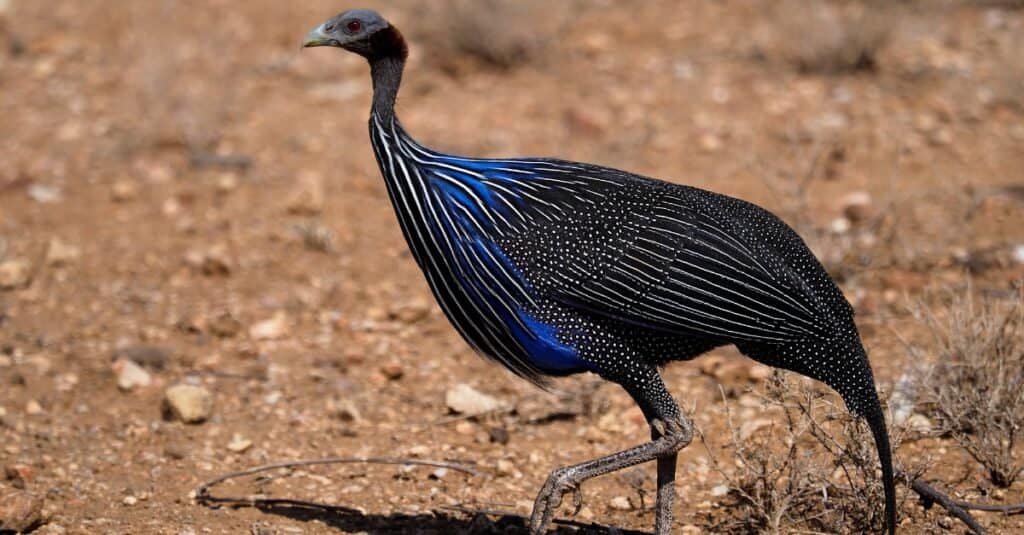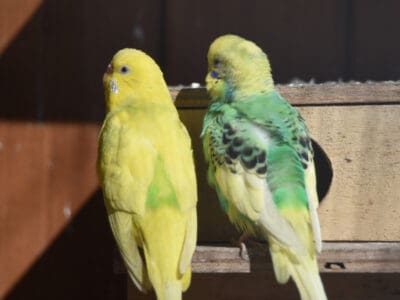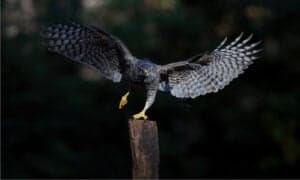Male vs Female Guinea Fowl: What Are The Differences?
Guinea fowls are interesting birds that are sometimes raised as pets and other times as farm animals to produce meat and eggs. Currently, four genera of this fowl and seven to ten species are recognized, but they are all a little different. We’re not here to compare species, though. Instead, we’re trying to answer a more common question: how can you tell the difference between a male and a female guinea fowl?
Well, we’ve come up with four elements of these animals that you can look at, aside from sex organs, to tell them apart. Although we are going to answer the question, you may still look out upon your growing flock and have difficulty separating the males and females.
Comparing a Male Guinea Fowl and a Female Guinea Fowl

A-Z-Animals.com
| Male Guinea Fowl | Female Guinea Fowl | |
|---|---|---|
| Size | Weight: 1 lb 9 oz to 3 lbs Height: 1.7 to 1.9 feet Length: 15 to 30 in |
Weight: 1 lb 9 oz – 3 lbs 8 oz Height: 1.7 to 1.9 feet Length: 15 to 30 in |
| Morphology | – Larger wattles and casque, or helmet, in the case of helmeted species – Wattle is usually cupped |
– Smaller casque, or crest, and more angled toward the back of the head – Smaller wattle – Less cupping in the wattle |
| Sound | – Monosyllable call that some people claim sounds like “chi” – Do not make two-syllable calls |
– Two-syllable call that sounds like “buckwheat” to some owners – They may also imitate males, too |
| Behavior | – Males will often chase female guinea fowls as they mature – Often, males will lower their heads and raise their wings before charging |
– Females may submit to the males after their charges, or they may flee |
The Key Differences Between a Male Guinea Fowl vs Female Guinea Fowl

The greatest differences between a male guinea fowl and a female guinea fowl include their morphology and the sounds they make. The male guinea fowl is known for having a larger wattle, a larger casque, and more cupping in the wattle structure, and they also make monosyllable calls. Female guinea fowls have smaller wattles and crest, and are known for making a two-syllable sound that differentiates them from males.
These are two ways that people identify the male and female versions of these birds. However, we need to go into greater depth to discuss these differences. That way, you can see the pains people must take when trying to figure out if they have a male or a female in the flock of birds.
Male vs Female Guinea Fowl: Size
Male and female guinea fowl do not have a very appreciable difference in their sizes. However, female guinea fowl are heavier than their male counterparts. It’s believed that the relative heaviness of females is due to their reproductive organs.
With that being said, the average male guinea fowl weighs up to 3 lbs, stands 1.9 ft tall, and measures between 15 and 30 inches in length. These are small birds. The female guinea fowl can weigh up to 3 lbs 9 oz, stands about 1.9 ft tall, and has a length of 15 to 30 in.
As you can see, the size difference between these birds is small. Since these are already small birds, it would be nearly impossible to use the size of these creatures to tell males from females.
Male vs Female Guinea Fowl: Morphology

EcoPrint/Shutterstock.com
The male and female guinea fowl look remarkably similar. Yet, we can use some morphological factors to tell the differences between the two. The first difference can be found in the wattle, the red caruncle hanging from the area where the beak connects to the face of the guinea fowl.
Males tend to have larger wattles than females, but that’s not the only difference. Male wattles have more cupping, or they tend to be more folded to produce a cupped shape. Still, even that doesn’t hold up in all cases.
Another morphological difference between males and females is that males’ casques (sometimes referred to as helmets) are larger in males than in females. Crested males have larger crests than females, too. Also, the females’ helmets are even more angular and seem to run toward the back of the head more.
These differences can add another valuable piece of the puzzle when figuring out how these two birds are different from one another.
Male vs Female Guinea Fowl: Sound
Male and female guinea fowls can be differentiated through the calls they make. Males will often call with a “single syllable” call that sounds like “kek” or “chi” depending on who you ask. However, females make a two-syllable calling noise that sounds to some like the birds are saying “buckwheat.”
However, both birds are equally loud and obnoxious with their calls. To make the matter of telling these animals apart even more difficult, the females can imitate the males. Thus, you might have a whole flock that is kek-ing one moment and then half of them are going to “buckwheat” the next.
The only helpful thing about all this is that males cannot replicate the two-syllable call of the females.
Male vs Female Guinea Fowl: Behavior

Erni/Shutterstock.com
Lastly, we can look to the behavior of the males and females to learn about their sex. Once the birds reach sexual maturity, the males will start to chase the females around. When they do this, the males will often lower their heads, raise their wings, and charge the females in an attempt to copulate.
The females, when receptive, will submit to the males. Other times, they will flee, leading to a short chase around your land. Generally speaking, if you see a guinea fowl chasing another in such a manner that we described, it’s a male.
As you can see, learning the differences between a male and a female guinea fowl is a process that is riddled with difficulties. Their size and morphology are very similar, and it’s hard to pick out sounds in a flock. If you rely on waiting for these birds to sexually mature, then you may not know what you have in your flock for a little while. After all, these birds reach full sexual maturity at 2 years of age.
Although these birds are loud and obnoxious at times, they are fun to watch. They’re also very helpful for eating ticks on your property while also providing meat and eggs! You can always contact local experts to help you sex your guinea fowl!
More from A-Z Animals
Guinea fowls are interesting birds that are sometimes raised as pets and other times as farm animals to produce meat and eggs. Currently, four genera of this fowl and seven to ten species are recognized, but they are all a little different. We’re not here to compare species, though. Instead, we’re trying to answer a more common question: how can you tell the difference between a male and a female guinea fowl?
Well, we’ve come up with four elements of these animals that you can look at, aside from sex organs, to tell them apart. Although we are going to answer the question, you may still look out upon your growing flock and have difficulty separating the males and females.
Comparing a Male Guinea Fowl and a Female Guinea Fowl

A-Z-Animals.com
| Male Guinea Fowl | Female Guinea Fowl | |
|---|---|---|
| Size | Weight: 1 lb 9 oz to 3 lbs Height: 1.7 to 1.9 feet Length: 15 to 30 in |
Weight: 1 lb 9 oz – 3 lbs 8 oz Height: 1.7 to 1.9 feet Length: 15 to 30 in |
| Morphology | – Larger wattles and casque, or helmet, in the case of helmeted species – Wattle is usually cupped |
– Smaller casque, or crest, and more angled toward the back of the head – Smaller wattle – Less cupping in the wattle |
| Sound | – Monosyllable call that some people claim sounds like “chi” – Do not make two-syllable calls |
– Two-syllable call that sounds like “buckwheat” to some owners – They may also imitate males, too |
| Behavior | – Males will often chase female guinea fowls as they mature – Often, males will lower their heads and raise their wings before charging |
– Females may submit to the males after their charges, or they may flee |
The Key Differences Between a Male Guinea Fowl vs Female Guinea Fowl

The greatest differences between a male guinea fowl and a female guinea fowl include their morphology and the sounds they make. The male guinea fowl is known for having a larger wattle, a larger casque, and more cupping in the wattle structure, and they also make monosyllable calls. Female guinea fowls have smaller wattles and crest, and are known for making a two-syllable sound that differentiates them from males.
These are two ways that people identify the male and female versions of these birds. However, we need to go into greater depth to discuss these differences. That way, you can see the pains people must take when trying to figure out if they have a male or a female in the flock of birds.
Male vs Female Guinea Fowl: Size
Male and female guinea fowl do not have a very appreciable difference in their sizes. However, female guinea fowl are heavier than their male counterparts. It’s believed that the relative heaviness of females is due to their reproductive organs.
With that being said, the average male guinea fowl weighs up to 3 lbs, stands 1.9 ft tall, and measures between 15 and 30 inches in length. These are small birds. The female guinea fowl can weigh up to 3 lbs 9 oz, stands about 1.9 ft tall, and has a length of 15 to 30 in.
As you can see, the size difference between these birds is small. Since these are already small birds, it would be nearly impossible to use the size of these creatures to tell males from females.
Male vs Female Guinea Fowl: Morphology

EcoPrint/Shutterstock.com
The male and female guinea fowl look remarkably similar. Yet, we can use some morphological factors to tell the differences between the two. The first difference can be found in the wattle, the red caruncle hanging from the area where the beak connects to the face of the guinea fowl.
Males tend to have larger wattles than females, but that’s not the only difference. Male wattles have more cupping, or they tend to be more folded to produce a cupped shape. Still, even that doesn’t hold up in all cases.
Another morphological difference between males and females is that males’ casques (sometimes referred to as helmets) are larger in males than in females. Crested males have larger crests than females, too. Also, the females’ helmets are even more angular and seem to run toward the back of the head more.
These differences can add another valuable piece of the puzzle when figuring out how these two birds are different from one another.
Male vs Female Guinea Fowl: Sound
Male and female guinea fowls can be differentiated through the calls they make. Males will often call with a “single syllable” call that sounds like “kek” or “chi” depending on who you ask. However, females make a two-syllable calling noise that sounds to some like the birds are saying “buckwheat.”
However, both birds are equally loud and obnoxious with their calls. To make the matter of telling these animals apart even more difficult, the females can imitate the males. Thus, you might have a whole flock that is kek-ing one moment and then half of them are going to “buckwheat” the next.
The only helpful thing about all this is that males cannot replicate the two-syllable call of the females.
Male vs Female Guinea Fowl: Behavior

Erni/Shutterstock.com
Lastly, we can look to the behavior of the males and females to learn about their sex. Once the birds reach sexual maturity, the males will start to chase the females around. When they do this, the males will often lower their heads, raise their wings, and charge the females in an attempt to copulate.
The females, when receptive, will submit to the males. Other times, they will flee, leading to a short chase around your land. Generally speaking, if you see a guinea fowl chasing another in such a manner that we described, it’s a male.
As you can see, learning the differences between a male and a female guinea fowl is a process that is riddled with difficulties. Their size and morphology are very similar, and it’s hard to pick out sounds in a flock. If you rely on waiting for these birds to sexually mature, then you may not know what you have in your flock for a little while. After all, these birds reach full sexual maturity at 2 years of age.
Although these birds are loud and obnoxious at times, they are fun to watch. They’re also very helpful for eating ticks on your property while also providing meat and eggs! You can always contact local experts to help you sex your guinea fowl!







